2000 LINCOLN CONTINENTAL heating
[x] Cancel search: heatingPage 13 of 232
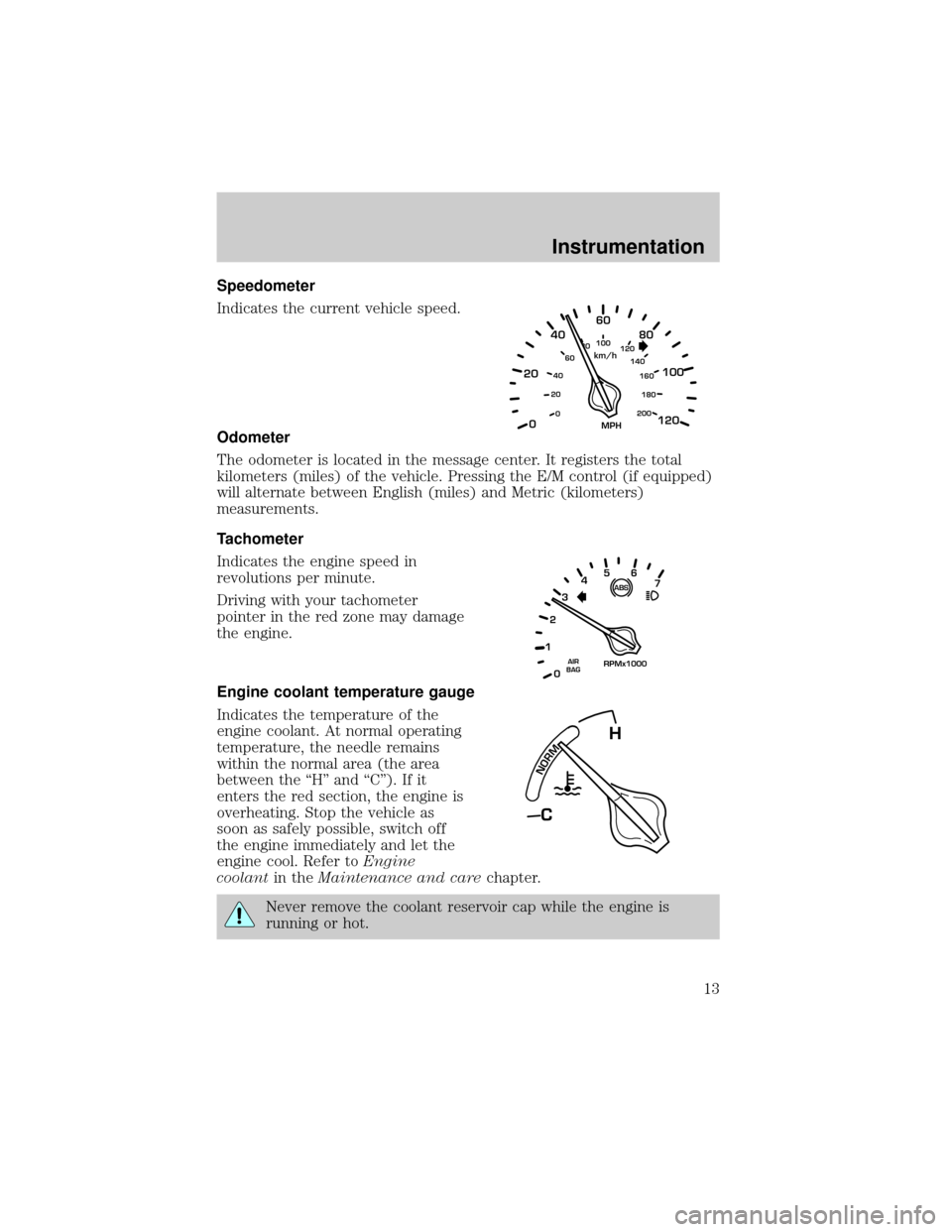
Speedometer
Indicates the current vehicle speed.
Odometer
The odometer is located in the message center. It registers the total
kilometers (miles) of the vehicle. Pressing the E/M control (if equipped)
will alternate between English (miles) and Metric (kilometers)
measurements.
Tachometer
Indicates the engine speed in
revolutions per minute.
Driving with your tachometer
pointer in the red zone may damage
the engine.
Engine coolant temperature gauge
Indicates the temperature of the
engine coolant. At normal operating
temperature, the needle remains
within the normal area (the area
between the ªHº and ªCº). If it
enters the red section, the engine is
overheating. Stop the vehicle as
soon as safely possible, switch off
the engine immediately and let the
engine cool. Refer toEngine
coolantin theMaintenance and carechapter.
Never remove the coolant reservoir cap while the engine is
running or hot.
80
MPH km/h0 2060
80
100
1200 204060100
120
140
160
180
200
40
ABS
RPMx1000AIR
BAG0 123456
7
NORM
CH
Instrumentation
13
Page 25 of 232
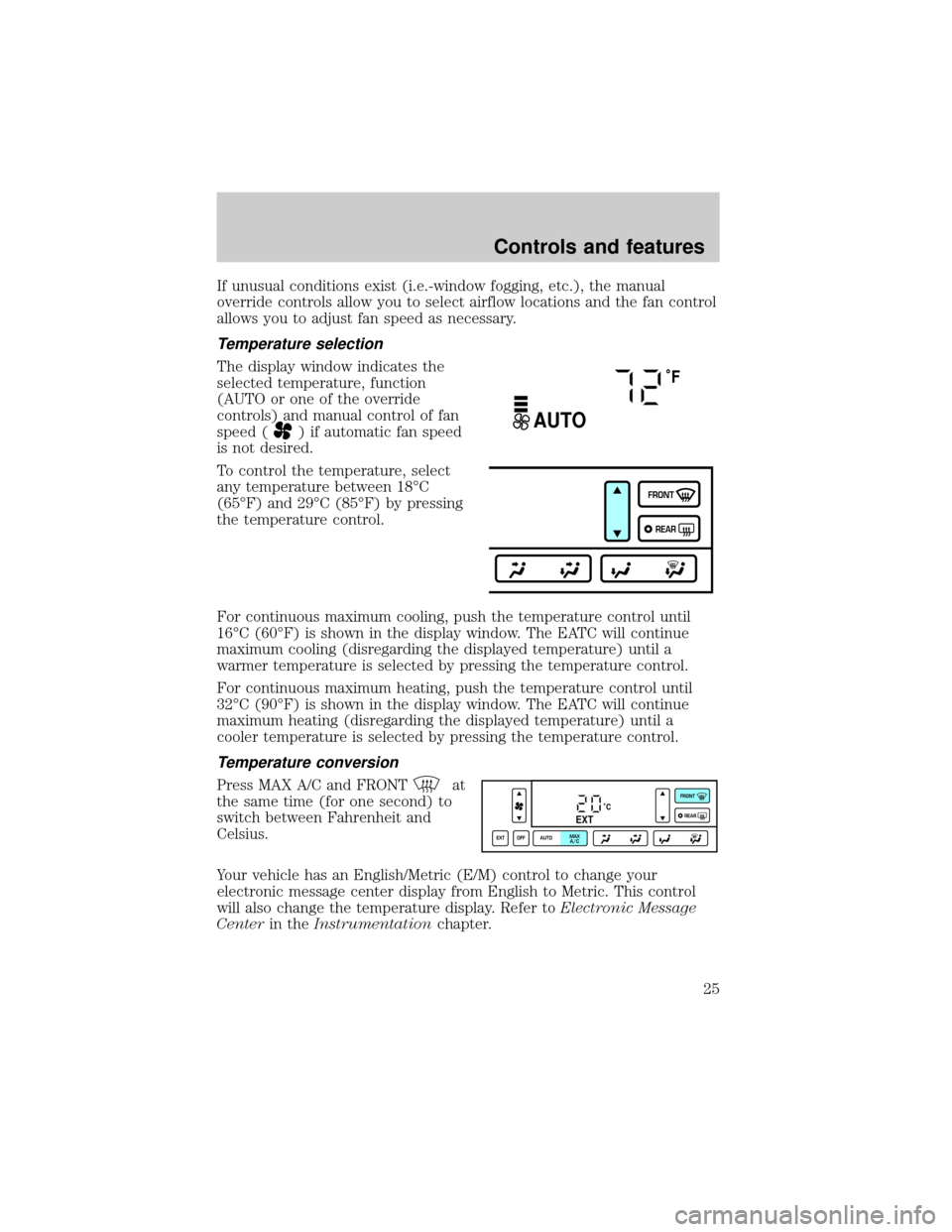
If unusual conditions exist (i.e.-window fogging, etc.), the manual
override controls allow you to select airflow locations and the fan control
allows you to adjust fan speed as necessary.
Temperature selection
The display window indicates the
selected temperature, function
(AUTO or one of the override
controls) and manual control of fan
speed (
) if automatic fan speed
is not desired.
To control the temperature, select
any temperature between 18ÉC
(65ÉF) and 29ÉC (85ÉF) by pressing
the temperature control.
For continuous maximum cooling, push the temperature control until
16ÉC (60ÉF) is shown in the display window. The EATC will continue
maximum cooling (disregarding the displayed temperature) until a
warmer temperature is selected by pressing the temperature control.
For continuous maximum heating, push the temperature control until
32ÉC (90ÉF) is shown in the display window. The EATC will continue
maximum heating (disregarding the displayed temperature) until a
cooler temperature is selected by pressing the temperature control.
Temperature conversion
Press MAX A/C and FRONTat
the same time (for one second) to
switch between Fahrenheit and
Celsius.
Your vehicle has an English/Metric (E/M) control to change your
electronic message center display from English to Metric. This control
will also change the temperature display. Refer toElectronic Message
Centerin theInstrumentationchapter.
˚F
AUTO
FRONT
REAR
˚CEXT
EXT OFF AUTOMAX
A/CFRONT
REAR
Controls and features
25
Page 27 of 232
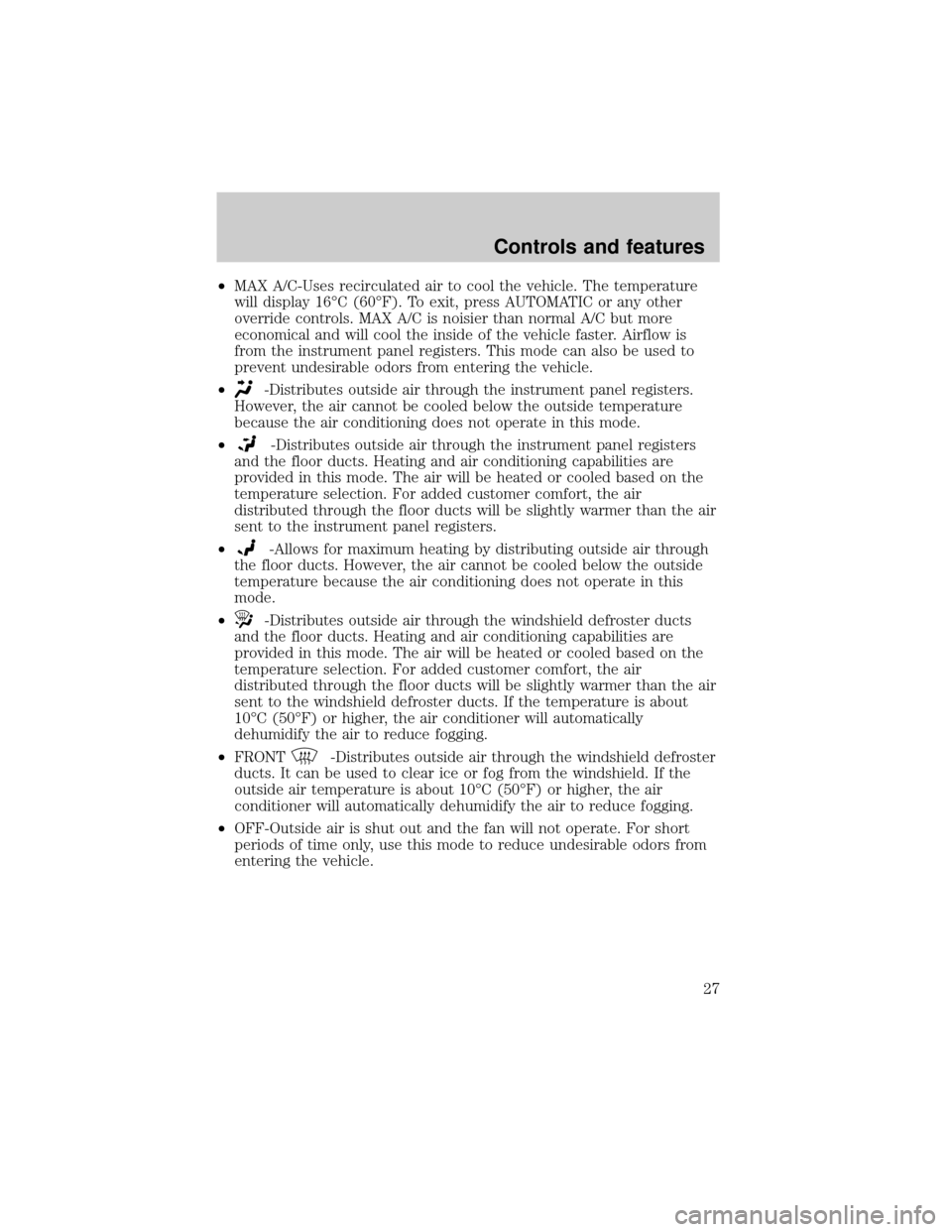
²MAX A/C-Uses recirculated air to cool the vehicle. The temperature
will display 16ÉC (60ÉF). To exit, press AUTOMATIC or any other
override controls. MAX A/C is noisier than normal A/C but more
economical and will cool the inside of the vehicle faster. Airflow is
from the instrument panel registers. This mode can also be used to
prevent undesirable odors from entering the vehicle.
²
-Distributes outside air through the instrument panel registers.
However, the air cannot be cooled below the outside temperature
because the air conditioning does not operate in this mode.
²
-Distributes outside air through the instrument panel registers
and the floor ducts. Heating and air conditioning capabilities are
provided in this mode. The air will be heated or cooled based on the
temperature selection. For added customer comfort, the air
distributed through the floor ducts will be slightly warmer than the air
sent to the instrument panel registers.
²
-Allows for maximum heating by distributing outside air through
the floor ducts. However, the air cannot be cooled below the outside
temperature because the air conditioning does not operate in this
mode.
²
-Distributes outside air through the windshield defroster ducts
and the floor ducts. Heating and air conditioning capabilities are
provided in this mode. The air will be heated or cooled based on the
temperature selection. For added customer comfort, the air
distributed through the floor ducts will be slightly warmer than the air
sent to the windshield defroster ducts. If the temperature is about
10ÉC (50ÉF) or higher, the air conditioner will automatically
dehumidify the air to reduce fogging.
²FRONT
-Distributes outside air through the windshield defroster
ducts. It can be used to clear ice or fog from the windshield. If the
outside air temperature is about 10ÉC (50ÉF) or higher, the air
conditioner will automatically dehumidify the air to reduce fogging.
²OFF-Outside air is shut out and the fan will not operate. For short
periods of time only, use this mode to reduce undesirable odors from
entering the vehicle.
Controls and features
27
Page 124 of 232
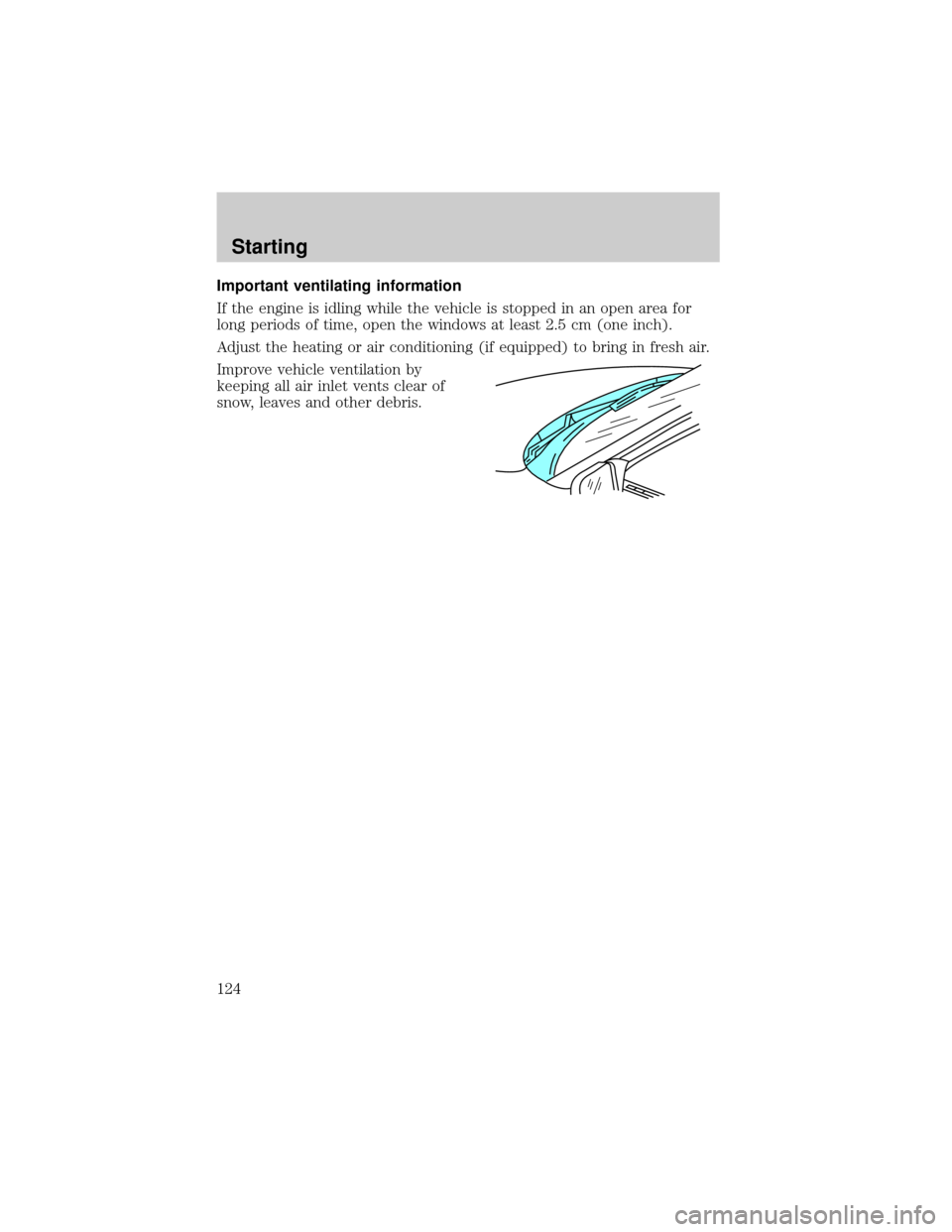
Important ventilating information
If the engine is idling while the vehicle is stopped in an open area for
long periods of time, open the windows at least 2.5 cm (one inch).
Adjust the heating or air conditioning (if equipped) to bring in fresh air.
Improve vehicle ventilation by
keeping all air inlet vents clear of
snow, leaves and other debris.
Starting
124
Page 128 of 232

reduction is realized via the fully electronic spark and fuel injection
systems. This process is very sensitive to driving conditions and very fast
acting. The front wheels ªsearchº for optimum traction several times a
second and adjustments are made accordingly.
The Traction Controlysystem will allow your vehicle to make better use
of available traction on slippery surfaces. The system is a driver aid
which makes your vehicle easier to handle primarily on snow and ice
covered roads.
During Traction Controlyoperation, TRACTION CONTROL ACTIVE is
displayed on the message center. You may hear an electric motor type of
sound coming from the engine compartment and the engine will not
ªrev-upº when you push further on the accelerator. This is normal
system behavior.
If you should become stuck in snow or on a very slippery road surface,
try switching the Traction Controlysystem off. This may allow excess
wheel spin to ªdigº the vehicle out or enable a successful ªrockingº
maneuver. Refer toMessage centerin theInstrumentationchapter.
If the Traction Controlysystem is cycled excessively, the brake portion
of the system will shut down to prevent the front brakes from
overheating. A limited Traction Controlyfunction using only engine
torque reduction will still control wheels from over-spinning. When the
front brakes have cooled down, the system will again function normally.
Anti-lock braking is not affected by this condition and will function
normally during the cool down period.
If a system fault is detected, CHECK TRACTION CONTROL is displayed
on the message center and your vehicle should be serviced.
STEERING
Your vehicle is equipped with power steering. Power steering uses energy
from the engine to help steer the vehicle.
To prevent damage to the power steering pump:
²Never hold the steering wheel to the extreme right or the extreme left
for more than a few seconds when the engine is running.
²Do not operate the vehicle with a low power steering pump fluid level.
If the power steering system breaks down (or if the engine is turned
off), you can steer the vehicle manually, but it takes more effort.
Driving
128
Page 176 of 232
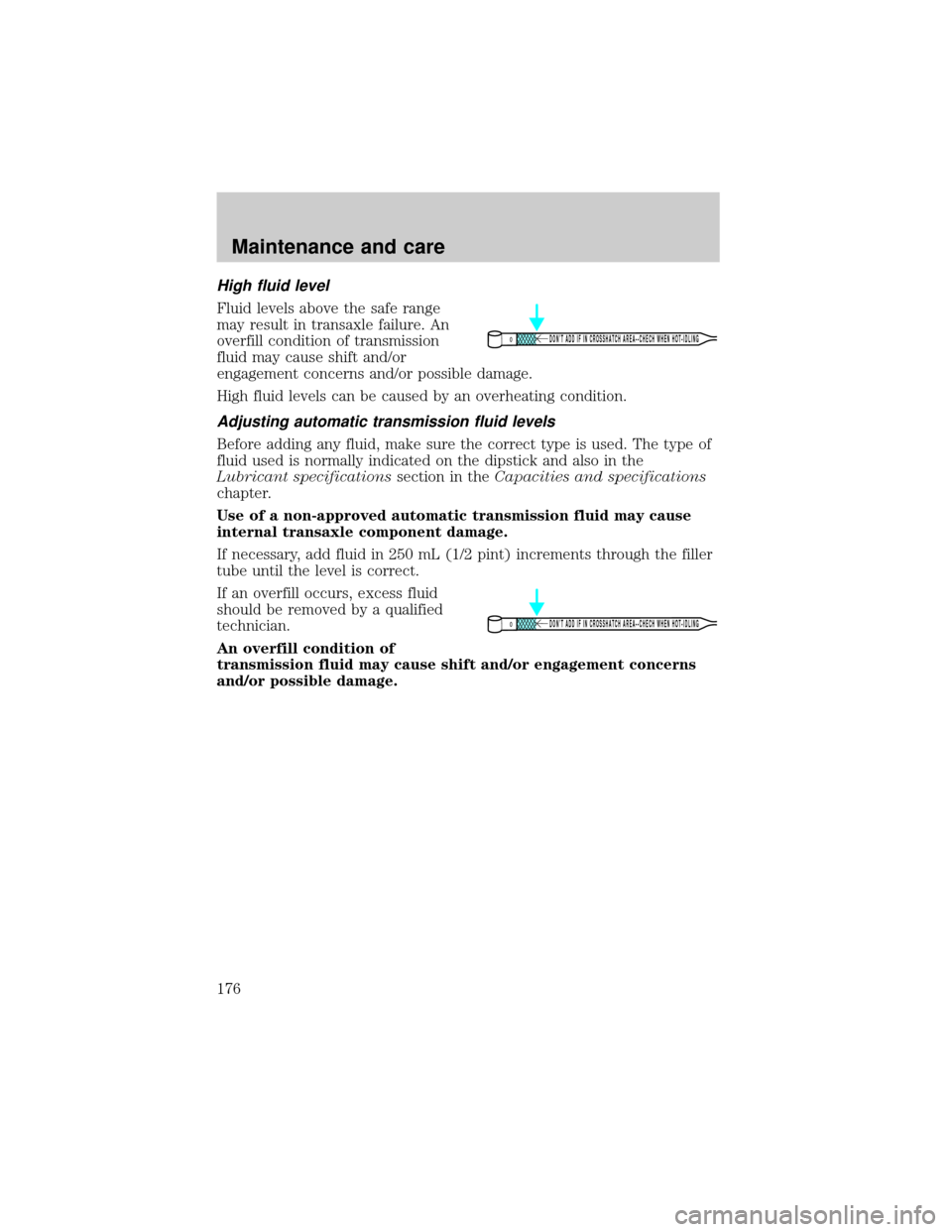
High fluid level
Fluid levels above the safe range
may result in transaxle failure. An
overfill condition of transmission
fluid may cause shift and/or
engagement concerns and/or possible damage.
High fluid levels can be caused by an overheating condition.
Adjusting automatic transmission fluid levels
Before adding any fluid, make sure the correct type is used. The type of
fluid used is normally indicated on the dipstick and also in the
Lubricant specificationssection in theCapacities and specifications
chapter.
Use of a non-approved automatic transmission fluid may cause
internal transaxle component damage.
If necessary, add fluid in 250 mL (1/2 pint) increments through the filler
tube until the level is correct.
If an overfill occurs, excess fluid
should be removed by a qualified
technician.
An overfill condition of
transmission fluid may cause shift and/or engagement concerns
and/or possible damage.
DON’T ADD IF IN CROSSHATCH AREA--CHECH WHEN HOT-IDLING
DON’T ADD IF IN CROSSHATCH AREA--CHECH WHEN HOT-IDLING
Maintenance and care
176
Page 226 of 232

Accessory delay ..........................76
Air bag supplemental
restraint system ..........104,105,109
and child safety seats ............106
description .......................105,109
disposal ....................................112
driver air bag ...................107,110
indicator light ...............9,108,111
operation ..........................107,110
passenger air bag ............107,110
side air bag ..............................109
Air cleaner filter .......................209
Air conditioning ..........................24
automatic temperature
control system ..........................24
Air filter, cabin ..........................179
Air suspension ...........................129
description ..............................129
Antifreeze
(see Engine coolant) ................169
Anti-lock brake system
(see Brakes) .......................125,126
Anti-theft system ........................79
arming the system ....................79
disarming a triggered system ..80
Audio system (see Radio) .........30
Automatic transaxle .................130
driving with .............................132
fluid, adding ............................174
fluid, checking ........................174
fluid, refill capacities ..............209
fluid, specification ..................211
Axle
lubricant specifications ..........210
Battery .......................................177
acid, treating emergencies .....177
charging system
warning light .............................11
jumping a disabled battery ....156
maintenance-free ....................177
replacement, specifications ...209
servicing ..................................177Belt minder ...............................100
Brakes ........................................125
anti-lock ............................125,126
anti-lock brake system
(ABS) warning light ..........10,126
brake warning light ..................10
fluid, checking and adding ....168
fluid, refill capacities ..............209
fluid, specifications ..........210,211
lubricant specifications ...210,211
shift interlock ..........................130
Break-in period .............................3
Capacities for refilling fluids ....209
CD changer .................................42
Certification Label ....................213
Child safety restraints ..............112
child safety belts ....................112
Child safety seats ......................113
attaching with tether straps ..117
in front seat ............................115
in rear seat ..............................115
Cleaning your vehicle ...............204
engine compartment ..............206
exterior ....................................205
exterior lamps .........................206
instrument panel ....................207
instrument panel lens ............207
interior ..............................207,208
mirrors .....................................205
plastic parts ............................205
safety belts ..............................208
washing ....................................204
waxing .....................................204
wheels ......................................205
windows ..................................208
wiper blades ............................206
woodtone trim ........................208
Climate control (see Air
conditioning or Heating) ............24
Clock ............................................30
Compass, electronic ....................69
calibration ............................71,73
Index
226
Page 228 of 232

gauge .........................................12
improving fuel economy ........192
octane rating ....................190,211
quality ......................................190
running out of fuel .................191
safety information relating to
automotive fuels .....................187
Fuses ...................................143,144
Garage door opener ....................65
Gas cap (see Fuel cap) ............189
Gas mileage
(see Fuel economy) .................192
Gauges .........................................12
engine coolant
temperature gauge ...................13
fuel gauge ..................................12
odometer ...................................13
speedometer .............................13
tachometer ................................13
GAWR
(Gross Axle Weight Rating) .....135
definition .................................135
driving with a heavy load ......135
location ....................................135
GVWR (Gross
Vehicle Weight Rating) .............135
calculating ...............................135
definition .................................135
driving with a heavy load ......135
location ....................................135
Hazard flashers .........................142
Head restraints ...........................92
Headlamps ...................................22
aiming ........................201,202,203
autolamp system .......................23
bulb specifications ..................201
daytime running lights .............22
flash to pass ..............................23
high beam ............................10,22
replacing bulbs .......................197
turning on and off ...............11,22
warning chime ..........................12Heating ........................................24
HomeLink universal
transceiver (see Garage
door opener) ................65,66,67,68
Hood ..........................................163
Ignition .......................................211
positions of the ignition ...........46
Infant seats
(see Safety seats) .....................113
Inspection/maintenance
(I/M) testing ..............................196
Instrument panel
cleaning ...................................207
cluster ...................................8,207
lighting up
panel and interior .....................23
location of components ..............8
Jump-starting your vehicle ......156
Keyless entry system .................85
autolock .....................................88
keypad .......................................85
programming entry code .........86
Keys .............................................47
key in ignition chime ...............12
positions of the ignition ...........46
Lamps
autolamp system .......................23
bulb replacement
specifications chart ................201
cargo lamps ...............................23
daytime running light ...............22
headlamps .................................22
headlamps, flash to pass ..........23
instrument panel, dimming .....23
interior lamps ...............53,54,200
replacing bulbs ..196,197,199,200
Lane change indicator
(see Turn signal) ........................48
Lights, warning and indicator ......8
air bag ..........................................9
anti-lock brakes (ABS) .....10,126
brake ..........................................10
Index
228